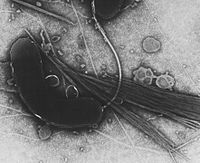|
Vikidia currently has 4,624 articles. Improve it! |
|
Join Vikidia: create your account now and improve it! |
Organism


An organism is a living being. There are many, many kinds of different organisms known on Earth, with about 8.7 millions species. Living beings can be as different as, for example, a yeast, an elephant, a bacteria or a mango tree, snakes, molds and tomatoes are also living beings. Even us, the human beings, are part of it.
Despite this seemingly huge diversity (called the biodiversity), all organisms share unique features, which make scientists to believe they're all descendants of a same common ancestor : they are all made of cells, with some of them having billions, while others can be made with only one. They all have a genetic information, bear by the DNA molecule. And they all have the same "language" to "understand" the genetic information (called the genetic code).
Classification[edit | edit source]
There are so many kinds of different organisms, that they are classified in different groups :
- Bacteria are usually one-celled organisms, with small cells.
- Archae looks like close to bacteria in first appearance, but are quite different when examined carefully. The live in extreme environments : acid lakes, hot springs... where other organisms couldn't survive
- Eucaryote have great cells with organelles in it. Some, like the amoeba, the yeast or the paramecium, have only one cell, while other can have many more, and thus being very big. The blue whale is the biggest animals on Earth.
- Plants are eucaryotes with green cells, that absorb the Sun's light to get energy. Green algae belong to that group.
- Red algae are close relatives of the plants, that were formerly placed into that group. They have red cells that act about the same way as plants, and allow them to live deeper in the water, where the Sun's light is scarce.
- Brown algae are distant relatives to plants and red algae. They are also able to thrive by using the Sun's light.
- Animals are always constituted with many cells. Some of them are very big, while other are quite small. They can't use Sun's light to feed, so they have to feed on other organisms : plants, or others animals. Many animals are able to move.
- Fungi are relatives to the animals. They grow and feed on the soil, or other surfaces.




